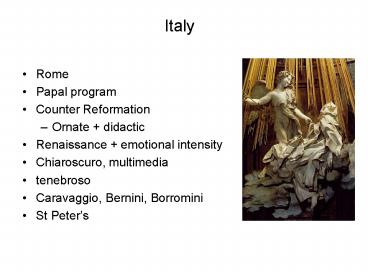Italy - PowerPoint PPT Presentation
1 / 42
Title:
Italy
Description:
Italy Rome Papal program Counter Reformation Ornate + didactic Renaissance + emotional intensity Chiaroscuro, multimedia tenebroso Caravaggio, Bernini, Borromini – PowerPoint PPT presentation
Number of Views:67
Avg rating:3.0/5.0
Title: Italy
1
Italy
- Rome
- Papal program
- Counter Reformation
- Ornate didactic
- Renaissance emotional intensity
- Chiaroscuro, multimedia
- tenebroso
- Caravaggio, Bernini, Borromini
- St Peters
2
Caravaggio Captures an instant
3
(No Transcript)
4
(No Transcript)
5
Spain
- Committed to Catholic orthodoxy
- Encourage devotion
- Saints martyrs
- Sp painters come into own
- Solemn, intense
- Impasto
- Velazquez
- Las Mininas
6
(No Transcript)
7
Flanders
- Southern Netherlands
- Church, state commissions
- Retained Catholic ties
- Heroic, royal
- Rubens, van Dyck
8
Rubens Queen of France Landing,
Marseilles 1623 Oil panel 25x20
9
portraiture
10
Dutch Republic - Holland
- Independence from Spain
- New subjects styles
- Amsterdam financial center
- Prosperity
- Protestant
- Merchant patrons
- Genre scenes, portraits,
- Still life, landscapes
- Painting dominates
- Rembrandt, Hals, Vermeer
11
Characteristics Dutch Painting-continued
understanding of human nature-wealthy
patrons-more excepting and tolerant to female
artists -other Baroque elements gttenebrism,
shallow space, motion, emotion,
etc.-naturalism-less intrigued with
mathematics(than H. Ren)-interested in light and
motion with a loose style that involved a
collection of brush strokes gtshowing
movement-more iconography, much more popular in
the North than in the South-genre
paintings-more secular than the South
12
1629
13
1669
14
(No Transcript)
15
(No Transcript)
16
(No Transcript)
17
(No Transcript)
18
(No Transcript)
19
Vermeer The Letter 1666 Oil canvas 17x15
20
France
- Monarchy, Louis XIV
- Paris art center
- Most powerful country
- Appeal of Roman classicism
- Trade, wealth patronage
- Shimmering glowing color
- Moral message
- Balanced, classicism
- Poussin, Lorrain
- Versailles
21
24.1 French Baroque Art
- In France, monarchical authority and power was
consolidated, and embodied, in King Louis XIV. - The foundation of the Royal Academy of Painting
and Sculpture in 1648 established French
classicism as the official style. - The practice of art and architecture were
regularized and organized and placed in the
service of the state. - King Louis XIV and his principal adviser,
Jean-Baptiste Colbert, used the power of art for
propaganda
22
- Georges de La Tour, Adoration of the Shepherds,
1645-1650. o/c - Influence of Caravaggio's style on Georges de La
Tour use of light and unidealized figures. Like
the Dutch Caravaggesque painters, the group of
humbly dressed figures gathered reverentially
around the sleeping baby Jesus is illuminated by
a single light source (a candle) included in the
painting.
23
England
- Limited monarchy
- Religious diversity
- Does not have focus
- Of other Baroque trends
- ARCHITECTURE
- St Pauls Cathedral
- Sir Christoper Wren
24
(No Transcript)
25
Women artists Renaissance to Baroque Renaissance
1st period, international fame Humanism
Individual opportunities education, growth,
achievement Cultural shift craftsmen ?
artists perspective, anatomy, mathematics
26
- Some transcended gender role expectations
- Fathers workshops - aristocratic connections
- Apprenticeship
- Women depicted as humans, not just muses
- Portraits, still lifes, religious
- Dutch Flemish successful
- changing art market opportunities
- Shift to Academy system
- Membership limited
27
- Women artist of the Baroque changed the way women
were depicted in art. Female artists during the
Baroque era were not permitted to train form nude
models because all nude models were male, but
they were very familiar with the female body.
Therefore, they created images of women as
conscious beings rather than detached muses.
28
Sofonisba Anguissola 1527-1625 Italian Spanish
Court Portraits
29
The Artists Sisters Playing Chess
30
(No Transcript)
31
Artemisia Gentileschi Italian 1593-1651
32
(No Transcript)
33
Penitent Magdalene
34
Esther before Ahasuerus, ca. 162835Oil on
canvas 82 x 107
35
Judith Leyster (16091660) Dutch Golden Age
36
Young Flute Player
37
The Concert
38
Clara Peeters Flemish Painter 1594-ca.1657
39
Still Life of Vase, Vase, Jug and Platter of
Dried Fruit, c. 1619
40
Fish, Oysters, and Shrimps, c. 1650
41
Still Life with Cheeses, Artichoke and Cherries,
1625
42
Academicians of the Royal Academy, 1772































